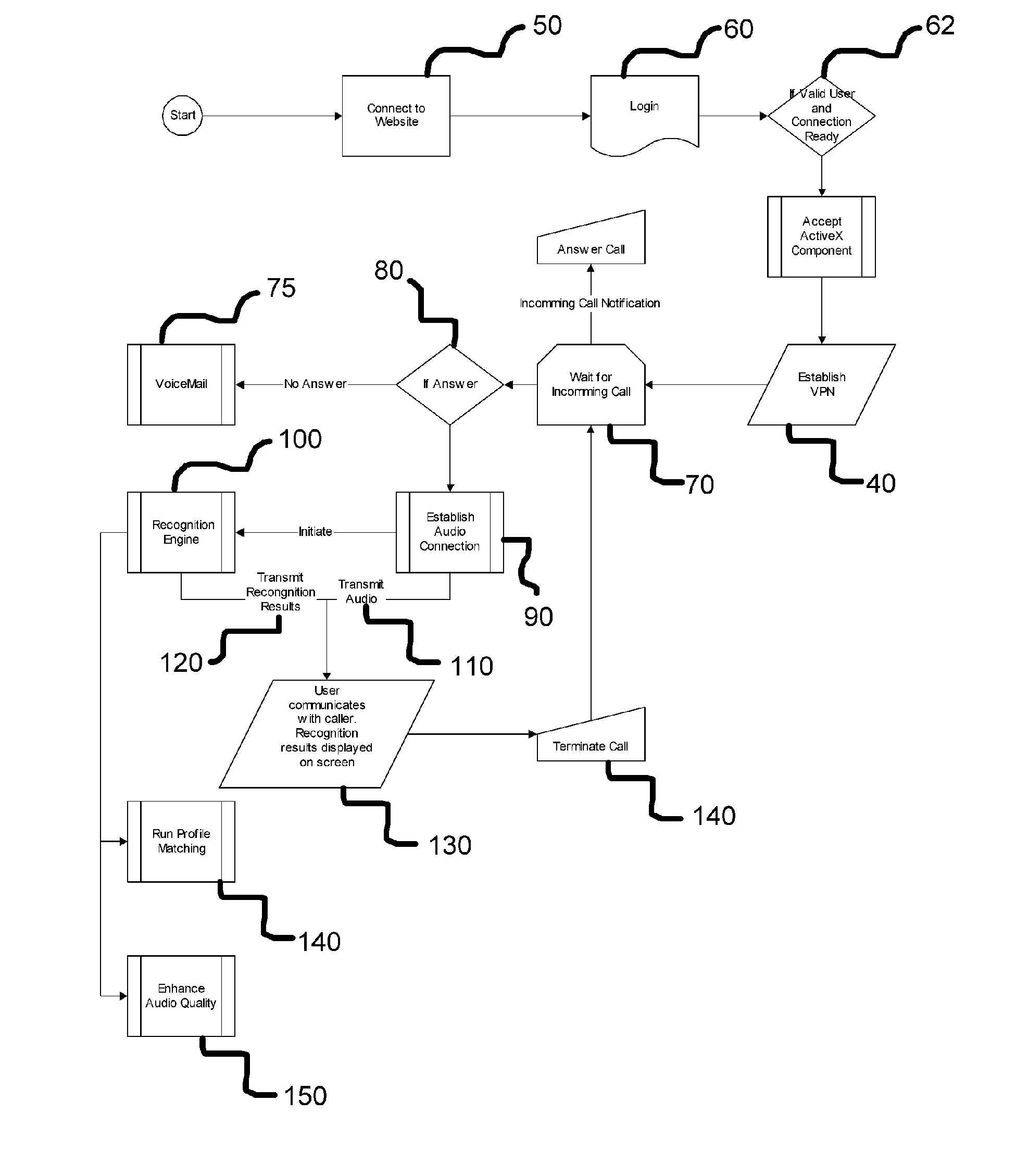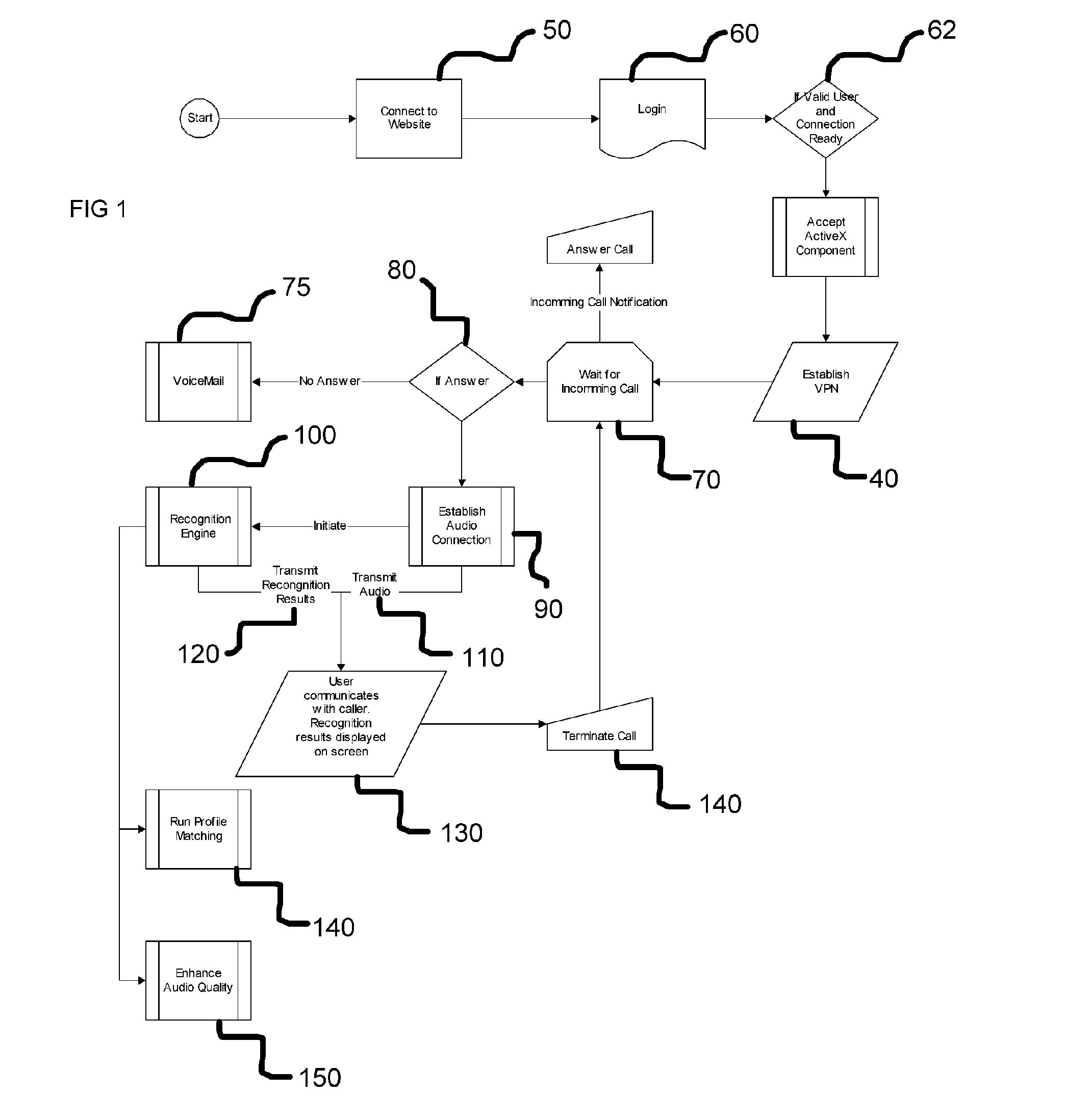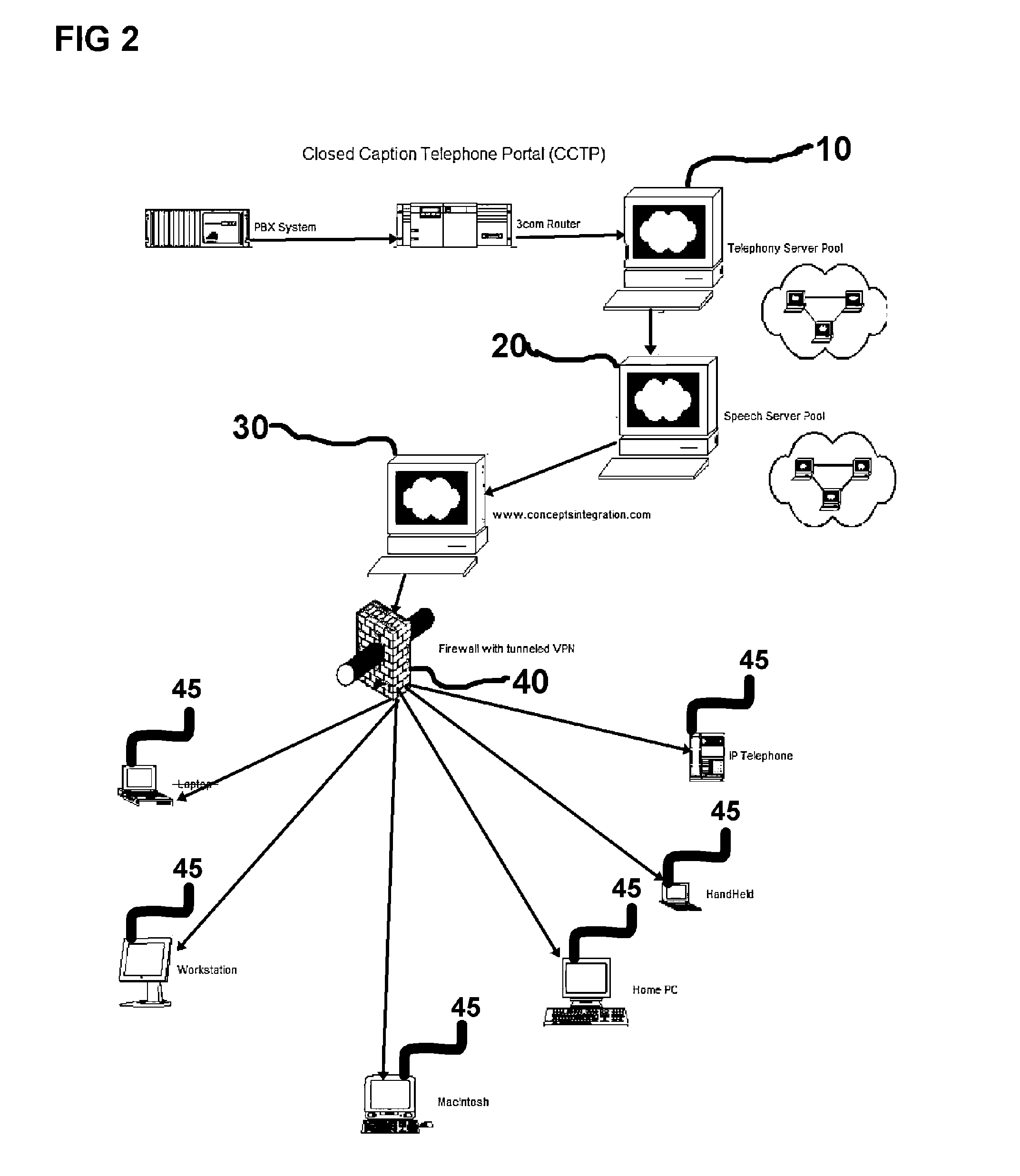[0016] The CCTP application is to be a revolutionary approach to telephone communication for the hearing-impaired. This
software entails a
client application stabling a Virtual
Private Network (VPN) to a
server application. Voice and text are transmitted simultaneously to the user from a
server farm. The
server farm utilizes a server-based application that enhances the current capabilities of
telephony servers and
speech recognition servers. The
software will be delivered to users through an
Internet website providing a subscription service to the user. This product will provide real time speech recognition results in a caption window, in order to provide
hearing impaired individuals with a text transcript of their live
telephone call. The CCTP application of the present invention will provide completely confidential, automated captioning to the user. No operators will be online and conversations will only be between the two parties. Additional security will prevent any unauthorized users from intercepting or
eavesdropping on any conversations.
[0018] Once the phone has been configured, all incoming and outgoing calls will
route though the present invention's speech servers. The routing of the telephone calls will not cause any disturbance to the
quality of service but the speech servers will interpret all audio streams, in order to provide real time
closed captioning. The speech servers will be configured with two additional features not part of
current technology. First, the speech servers will provide automated
noise canceling, eliminating sounds outside the range of human hearing. These sounds can be found in nature and can be created from analog telephones. The underlying tones will be identified and will be eliminated as speech is not within this
decibel range. The
clean up of the sound will affect only the audio transmission to the speech server and will not affect the overall
sound quality for the user. Second, the system will provide an automated profile matching system that will optimize the performance of the recognition engine.
[0019] Most speech recognition engines provide a profile for users to be able to
train the computer for their voice. Each individual'
s voice is unique based on the vocal pattern of words and sounds. The CCT application will mesh vocal patterns and evaluate profile recognition confidence ratings to locate a more viable and consistent profile. A
database will be used to store the vocal patterns of profiles and will have identifying factors indexed to allow for rapid retrieval of patterns closely matching the caller's patter. The system will leverage all profiles stored on the server and will identify profiles based on the vocal pattern of each. Profiles that more closely match the caller's vocal pattern will be instantiated in the background with simultaneous
processing on both the primary profile as well as the identified matching profiles. The system will analyze the current and alternate profiles and the resulting recognition
confidence factor evaluated. Through this process the speech recognition engine will dynamically adjust the caller profile until the highest recognition
confidence factor is reached. This process will be conducted asynchronously and will be transparent to the caller and the user of the application. Once a valid profile has been located the system will replace the default profile with the more closely matched profile providing better recognition results.
[0021] Contrary to the voice identification model, profile matching will not require callers to speak a set
phrase over and over. Instead common words will be identified and matched to patterns. As the recognition engine is capable of returning the valid word from the spoken voice these “snippets” will be matched against the
database to find other similar patterns. Providing a “Natural Voice Identification” system, the CCTP will not look to match names or identities, instead the CCTP is focused on matching the patterns to achieve a more accurate result for voice recognition.
[0022]
Background noise can cause greater problems with speech recognition than any other factor. With the
elimination of
background noise, recognition rates dramatically increase in every circumstance. Therefore, the CCT application focuses on the
elimination of the
white noise common on analog phone systems and digital cellular systems to increase the quality of the audio quality prior to the recognition engine evaluating the incoming audio
stream. The CCTP will work to minimize the
Signal to
Noise ratio by decreasing ambient
noise factors. The effectiveness of this will be measured in an improvement of 10 to 25 decibels. Decibels (dB) are a measure of the speech
signal and the noise
signal power. A dB improvement of 20 for example means that the Sound
Noise Ration (SNR) of the extracted
signal and the SNR of the original signal has a difference of 20 dB. Decibels are measured on a log scale referenced to base 10. ex. SNR=10 log (speech power /
noise power). The original signal has a SNR of 0 dB, if speech power (SP) equals the
noise power (NP) of the original signal. If the SP is 100 times the NP in the extracted signal, the extracted signal has an SNR of 20 dB, because 10×log(100)=20. Since 20−0=0, the SNR improvement between the extracted signal and the original signal is 20 dB.
[0025] Through the use of the centralized speech recognition servers all applications developed to interface with the CCT and the CCC systems will provide a
fuzzy logic, multi-
modal interface.
Fuzzy logic is a structured, model-free estimator that approximates a function through linguistic input / output association. This interface will allow users to take
advantage of basic and advance functionality without learning a complex set of functional codes. All interaction with the system will be voice enabled as well as keystroke and mouse accessible. Users will be offered an initial set of pre-defined commands to interact with the system. These commands will be
fuzzy logic enabled and will be capable of
parsing out statement such as “would you please”, “please” and “I would like to” and remove them from the command structure to enable users to interact with the system in as realistic a manner as possible. This
fuzzy logic module will be enhanced over time and will provide added benefits to the users.
 Login to View More
Login to View More  Login to View More
Login to View More 


